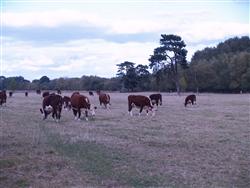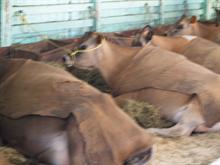Study Cattle Production
Expand your knowledge of cattle production. Improve your business or employment prospects on farm. This course will help you develop the necessary skills to successfully run a cattle farm. It covers a range of different aspects, and gives the option of selecting electives that best suit your interests.
To sustain livestock production on a property:
- Select breeds of livestock appropriate to the site
- Control overstocking
- Use an appropriate production system
- Apply appropriate land care practices to sustain the condition of
the land (eg. subdivision fencing according to soil types and land use).

Course Duration: 100 hours
Course Structure
There are six modules in this course as follows: five core modules and one elective.
Core Modules:
Elective Modules:
Select one of the following.
Enrol Today
Ready to get started? Click on the orange enrol now button.
Have questions? Click here to email our course counsellors.
The Role of Beef Cattle in Agriculture
Beef cattle have a useful and necessary role in agricultural production for the following reasons:
- Beef provides protein and some minerals and vitamins which are necessary to human health and which balance other nutrients that are obtained from plant foods. Animal protein (meat) contains amino acids which are essential to the growth and development of humans. In general, children cannot grow properly without the protein obtained from meat, milk and eggs. Vegetarians can be healthy on a meat-free diet provided they are extremely careful about their diets.
- Beef is always in demand to satisfy human appetites. People like the taste of beef and as the standard of living and incomes rise throughout the world, the demand for animal products also rises. Developed countries eat the most meat per person while the underdeveloped countries eat the least.
- Cattle are ruminants that convert non-human foods into protein. Beef cattle convert grass and roughage (which can't be eaten by humans) into high quality human food.
- Ruminants use native pastures and by-products from arable crops such as straw. These products are available on farms but have little resale value. They are converted into saleable products by processing them through the ruminant animal.
- Beef cattle produce manure which feeds the soil and maintains soil structure. This increases the production of the arable crops on the farm.
- Beef cattle can make use of marginal land. Although the greatest demand is for the high energy plant foods such as cereals and oil seeds, the amount of usable land in the world is limited. Marginal land which is unsuitable for high value cropping can used efficiently used for beef production.

Choosing a Dairy Breed
There are real differences among the dairy breeds in size, maturity, fat content of the milk and other important features. In selecting a breed, the farmer will do well to examine his farming enterprise with care and to choose a breed that suits his requirements. The availability of both cows and bulls is an important consideration in this choice. For example, Jerseys are far more heat resistant than Holstein-Friesians and are also better foragers. Therefore, Jerseys are more suited to hotter areas and to more extensive dairying. Ayrshires are also said to be good foragers but are more sensitive to poor handling than are Holstein-Friesians or Jerseys.
Animals can usually adapt to a new environment, but this can be a lengthy process. Buying animals from an area with similar climatic conditions, preferably close to your locality, is a recommended practice.
The choice of a dairy breed usually depends on one or more of the following:
-
The breeding stock available in the area and the cost of these animals
-
The adaptability of the selected breed to local conditions such as climate, feed and grazing conditions
-
The reproductive capacity of the breed and its ability to produce good quality milk
-
Personal preference and past experience of the farmer.
Comparison of Dairy Breeds
The differences in the production of dairy breeds can be studied from the records made under various registers of the breeds and from information which is widely published on herd performance tests. Performance testing is a measured performance of the animal against a background of careful breeding and selection. The following section gives a brief overview of the primary features of the six main dairy breeds.
Principles of Good Calf Rearing
The objective of good calf rearing is to produce healthy animals that will continue to grow into suitable dams for vealer herds, suitable steers or heifers for beef production, or suitable replacement heifers for dairy herds.
A good calf-rearing program should aim for:
Minimal losses from disease and death
Good animal performance, optimum growth rate and feed efficiency
Optimal input costs and other operating costs
Minimum labour requirements
Best utilisation of existing facilities
There is no set or best way to rear calves. Many different combinations of feeding, housing and husbandry can be successful. What is important is that the producer (or person rearing the calf) understands the scientific principles of calf growth, nutrition, health and calf behaviour so that they can develop a system of husbandry that can be successfully modified to their own situation. This way, if things do go wrong, management can be altered in an informed way in order to put things right.
Remember, good calf-management requires a certain degree of basic knowledge and empathy with the animals, and a large dose of common sense.
Pre-Calving Management
Calves that receive inadequate attention during the first few weeks of life:
- Will not meet live-weight targets thus delaying age at first calving
- Are more prone to disease
- Cost more to rear
Attention to detail is the critical component of any successful calf rearing regime. This includes preparation of the cow for calving, monitoring the birth, providing suitable housing for calf rearing, a proper feeding regime for the animal, a disease prevention program in conjunction with a strict hygiene code of practice and the use of veterinary assistance when required.
Farm Management: Planning
What is planning and why is it important to farm management?
Farm Management involves the whole operation of a farm or agricultural business as a profit making venture, as such it involves the balanced integration of all aspects of these businesses.
Good farm related management does not just depend on following a set of routine procedures. It involves constant re-assessment of procedures and the need to be aware of new developments in technology, fluctuating costs and markets, and climatic patterns, as any small changes in these can significantly alter the economic viability of an enterprise.
Planning might relate to physical or tangible things such as the physical layout of an area of land, or intangible non physical things, such as the way manpower and other resources might be allocated in the workplace.
Formal planning helps to define the farm business goals, establish and overall strategy and develop individual plans.
Formal planning is important because it:
- Provides direction
- Reduces uncertainty
- Minimises waste and redundancy
- Sets goals/standards for control
- Assesses external and internal impacts to object relationships within the business
- Sets planning time frames (i.e. for review/completion etc.)
Plans can be broad in scope involving every aspect of a farm's future; or they can be narrow e.g. covering the way a small number of people will work for a short period of time. Strategic plans are plans which have been developed with the purpose of meeting these goals. A strategic plan utilises predetermined "strategies" in its approach to management.
There are some aspects of business management that are universal to all successful enterprises and financial management is one of these.
Pasture Management
Poor quality soils affect pasture species and restrict the type of pasture that can be grown. You will need to be able to identify the soil types and land classes on your property so that you can choose areas that you know will respond to improvement.
Low temperatures may restrict growth in winter, and the frequency of frosts or snow fall will limit the distribution of summer growing plants. Higher summer temperatures, even in the presence of abundant rainfall, can prevent the survival of many species of temperate origin. The length of daylight can affect the initiation of flowering in many plants resulting in changes to the setting of seed and affecting the ultimate survival of the plant. Variations in latitude can determine the limits within which some plants can be grown.
Different stock will graze in a variety of ways. Sheep graze close but cannot handle long grass; goats browse on bushes while cattle eat long grass and are not as selective as sheep. Natural pasture is also constantly changing and developing according to the environment and number and types of animals that graze it. The changes can be good or bad. They are not always noticeable as they can take place very slowly. There is no doubt that man and animals have the ability to make rapid and bad changes to our native pastures.
A further problem is that farmers rarely have one sort of pasture. Most farms will have some natural pasture and some improved pastures. The natural pasture is often a mix of grasses/legumes with some suiting one type of animal and others that suit a different type of stock. The improved pastures on a farm are specially planted to provide grazing at various times of the year and so need quite different management. By understanding all the different parts that affect grassland, a farmer can begin to effectively manage his most important resource - his grazing.
Pasture research worldwide has meant pasture plant species are constantly being introduced and evolved to meet specific requirements. Plant breeding, plant introduction, and widespread pasture trials continually provide new material adapted to the more difficult climatic conditions and help to extend the boundaries of sown pastures.